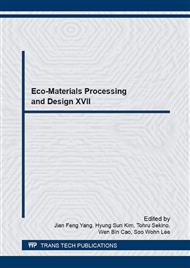p.38
p.43
p.50
p.56
p.61
p.68
p.73
p.79
p.84
Dielectric Properties of Liquid Crystal Polymer Composites with High Thermal Conductivity
Abstract:
Liquid crystal (LC) polymer, composited with inorganic filler, has a broad application prospect in electronic and electrical industry. In this research, permittivity (εr) and dielectric loss tangent (tanδ) of LC composites under different temperatures and frequencies were investigated, and activation energies were calculated and analyzed. At low temperatures and high frequencies, LC composites exhibited well dielectric properties. εr changed a little (3.6~4.0) in temperature range of-60°C~160°C when frequency was higher than 10Hz, but increased sharply when temperatures was higher than 100°C and frequency was lower 10Hz. The tanδ increased sharply with increasing temperature when temperatures was higher than 100°C and frequency was lower than 102Hz, and when frequency was above 102Hz, the value of tanδ changed gently (10-3~10-2). The peak of tanδ would translate to higher frequencies direction with increasing temperature in tanδ-frequency curve, and to higher temperatures direction with increasing frequency in tanδ-temperature curve. Activation energy is calculated by fitting the peak of the imaginary of the electric modulus, and activation energy is 0.43eV in low temperature and 1.59eV in high temperature.
Info:
Periodical:
Pages:
61-67
Citation:
Online since:
August 2016
Authors:
Price:
Сopyright:
© 2016 Trans Tech Publications Ltd. All Rights Reserved
Share:
Citation:


